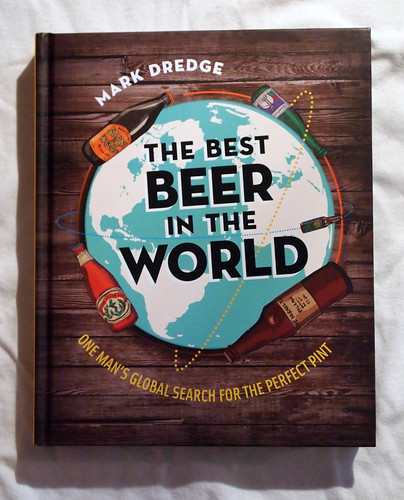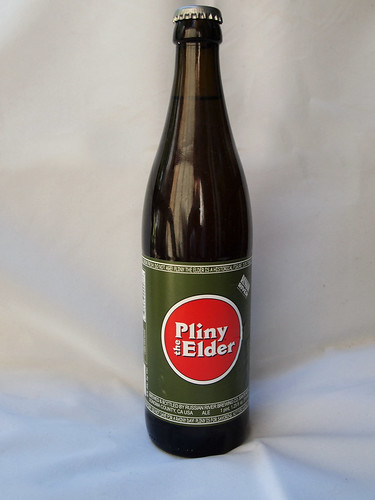On the back cover of The Best Beer In The World, a new book by British beer writer Mark Dredge, a copy editor at Ryland Peter & Small Ltd. publishing house has written this whopper of a misplaced modifier:
Part travelogue, part city guide, and part reference book, Mark takes you on a journey around the globe through great beers, bars, and brewer, immersing you in the best stories along the way.
Mark Dredge is not a reference book. I'm fairly certain that he is a real person. His book, however, is indeed "part travelogue, part city guide, and part reference book."
Will Mr. Dredge answer the book's title question? As above, that claim may have been an editor's fancy. The Best Beer In The World, as I'm reading it so far, seems more about finding good beers in many places than stalking a golden grail. But done so, written entertainingly and discussion-provokingly.
On page 144, for example, Mr. Dredge engages in an interesting exercise. He attempts to place American IPAs in ten style categories.
- 1. The original American IPA
Mid-1990s onward
Toffee-like malt in the background with a burst of floral, grapefruity hops in the aroma and the flavor. The moderately high bitterness is balanced against the malt sweetness, though still punches hard. These are the early defining American IPAs, and still stand up today.
Try: Lagunitas IPA; Bear Republic Racer 5.
- 2. West Coast IPA: the early years
2000-onward
The hugest of hop hits, resinous, pithy, citrusy, with a very high bitterness, often completely unbalanced. The use of caramel and crystal malts bulks out the body but you probably won't notice more than the brutal hops. Try: Green Flash Palate Wrecker; Stone IPA
- 3. West Coast IPA: the less-bitter middle years
circa 2007-onward
The huge hop aroma remains, it still gives all the qualities you expect, with lots of dank pine and citrus pitch, only now, there's some balance in the beers, even at the extreme top end —less bitterness, less malt, but still some toasty sweetness.
Try: Ballast Point Sculpin IPA; Firestone Walker Union Jack IPA
- 4. West Coast IPA: the next years
circa 2010-onward
Seemingly the hops have shifted from being the bittering addition and have instead been added as late or dry-hops. Bodies have slimmed, bitterness reduced, aromas use more recent hop varieties (Mosaic, Citra, etc.) than the classic C-hops [Cascade, Centennial, Chinook, etc.], but flavors are still big and bold.
Try: Stone Enjoy By IPA; Societe The Pupil
- 5. East Coast IPA
circa 2010-onward
An early form of the style, but still around today. These are maltier than the West, some caramel and toasty depth, less of the harsher malts, more floral and grapefruity instead of resinous and juicy (maybe from British hops), rounder mouthfeel, and less pronounced bitterness.
Try: Dogfish Head 60 Minute IPA; Brooklyn East India IPA
- 6. Northwest IPA
These are all about the hop aroma and flavor where the beers are top-heavy with fruity, citrusy, piney hops. Importantly, they are alos often unfiltered which adds to the simple grain bill and gives body and a general malt richness without sweetness.
Try: Deschutes Freshly Squeezed; Gigantic IPA
- 7. Midwest IPA
Think oranges, marmalade, orange soda, and floral, where a sweetness of malt gives a caramel richness to the brew and balances the bitterness. These likely use the classic American C-hops rather than newer varieties.
Try: Bell's Two Hearted IPA; Goose Island IPA
- 8. Colorado IPA
Lots of caramel malts pack the body with a lip-sticking sweetness and a toasty, toffee-ish flavor, while the hops aggressively come in to balance that bitterness and then throw out some dank, pithy aroma.
Try: Oskar Blues Gubna; SKA Modus Operandi
- 9. Vermont IPA
Similar to Northwest IPAs, these are very aromatic, fruity with citrus and tropical, lots of floral aroma, and the hop flavor is loaded throughout. Expect a hazy and relatively full body because they're unfiltered, where there's a juicy mix of hop and malt to balance the brews.
Try: The Alchemist Heady Topper; Fiddlehead IPA
- 10. Russian River IPA
This arguably stands alone as one brewery's defining impact on the style. Loads of hop aroma, zesty and fresh, piney and floral, citrus, then a very dry, pale, clean body of malt. In many ways, this type of beer is becoming the standard of American IPA today and reflects back to the current West Coast IPA.
Try: Russian River Blind Pig; Russian River Pliny the Elder
Mr. Dredge does not mention historical American IPAs, such as Ballantine (even though Pabst, of all breweries, has recently resuscitated it). Even so, such a cataloging might be an ever-fungible task. IPA, as Mr. Dredge points out, has become the defacto flagship of all 'craft' beer. Just a month after his book's publication, he added an eleventh paradigm, at his blog, Pencil and Spoon, an IPA-type he called Fresh Tropical Fruit Juice IPA.
These new IPAs are unfiltered (sometimes hazy, sometimes properly murky) and very pale in colour. The intensity bitterness is low and character malts are non-existent. The time of them being super-dry and bitter has shifted towards softer, rounder bodies with some residual sweetness, though you don’t immediately notice that texture because the hop aroma is so dominant, so powerfully wowing, with the aroma sticking to the subtle sweetness in the beer, and giving the unmistakable qualities of fresh fruit juice – pineapple, mango, peaches, melon, papaya, lychee. There’s also a new focus on freshness to capture those aromas at their very juicy best – two weeks old is becoming too old (don’t underestimate this and it's not like these enjoy before they die IPAs: the draft-only, local-only – perhaps brewery-bar-only – hyper fresh IPA is nearby).
Mr. Dredge notes that Black IPA — a jumble of hops and dark malt, ill-begotten to begin with (my thoughts, not his)— is a dying 'subcategory,' as is White IPA — a mash-up of a spiced wheat ale with a hoppy ale.
But not so, the so-called Session IPA, or, as I refer to it, VHPA (Very Hoppy Pale Ale). Really just a subset of any of the above eleven styles but brewed to a lower alcohol level (and that percentage varies brewer to brewer), Session IPA is currently enjoying a me-too rage. As are fruited IPAs, which, contrary to Mr. Dredge's assertion, are still sprouting like over-ripe fruits at farmers' markets.
Mark Dredge's Linnaeic attempt could be considered futile or valiant, but it might stand as a useful reference snapshot of what (American) IPAs are now. As he wrote at his blog:
One thing this change is doing is re-focusing on the American IPA. In the last five years we’ve seen the IPA-ification of all beers ...
... a practice which, now running amok, debases IPAs' very identity. American India Pale Ale? India has little to do with it.
-----more-----
- The Best Beer In The World
One Man's Global Search for the Perfect Pint
Hardcover: 224 pages
Publisher: Ryland Peters & Small Ltd. (U.K., October 2015)
Language: English
ISBN-10: 1909313718
ISBN-13: 978-1909313712 - Mark Dredge on Twitter: @MarkDredge
- Mark Dredge blog: Pencil and Spoon.
- Hours after I posted here, Oregon beer writer Jeff Alworth published a piece, at his blog Beervana, on how American IPAs have been evolving from hop bitterness predominance toward hop flavor and aroma emphasis.
- It reminded me of something I had written ... in 1998:
At the Mid-Atlantic Beer and Food Festival, at least 40% of the attendees were women. This a proportion that had been growing at this festival since its inception five years earlier. For the most part, these women were bucking the conventional wisdom that women only drink sweet, flavored, or fruit beers. They were sampling all of the beers. (This illogic, unfortunately being practiced by some craft breweries, of pandering to the least common denominator, is similar to the process that led the big American brewers to dumb down their offerings.)
Particularly intriguing was a conversation between two women who appeared to be just past the minimum age. They were standing in line, eagerly waiting to receive refills of Hop Devil Ale, an India Pale Ale, brewed in Pennsylvania by the Victory Brewing Company, that is big, bold, very bitter, and very aromatic. These women, however, were not remarking upon the bitterness of the beer, but, rather, upon its hoppiness, that is, its fresh herbal aromatics.
Too often, many of us refer only to bitterness when we talk of hop quality, as in the macho muscling in of as much 'hair-on-your-chest' bittering as possible. We forget about the appealing bouquet that hops impart to beer. Hops are herbs, after all. In cooking, spices such as allspice or cinnamon are thought of as sweet spices. They aren't sweet, per se, but, rather, confer a sweet character to the foods in which they used. Similarly, the aromatic character of hops lends a fruity, herbal character to a beer quite distinct from maltiness. This is especially true when dry-hopping with fresh hop blossoms. Compare this process to adding fresh herbs to a meal, after cooking. - For more from YFGF:
- Follow on Twitter: @Cizauskas.
- Like on Facebook: YoursForGoodFermentables.
- Follow on Flickr: Cizauskas.
- Follow on Instagram: @tcizauskas.













No comments:
Post a Comment
Comment here ...